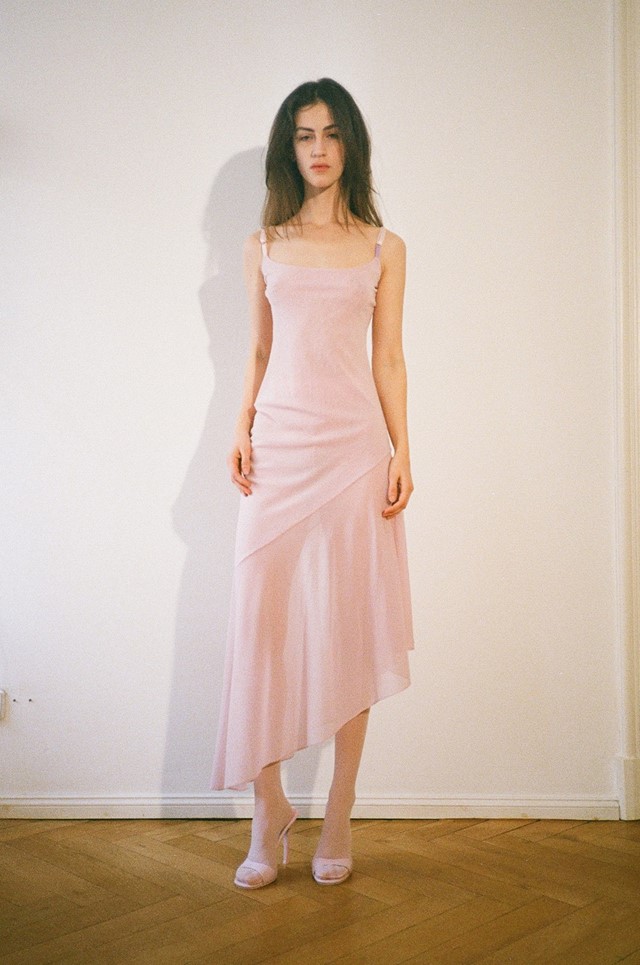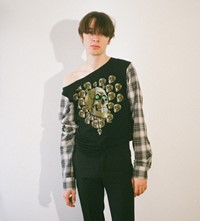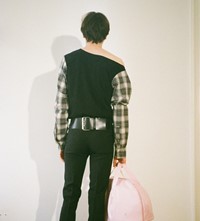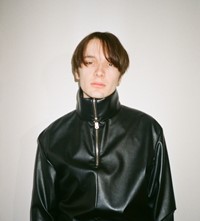Dimitri Arvanitis is inspired by the pre-social media age of fashion and youth culture
- TextHannah Tindle
Name/Brand: Dimitri Arvanitis
Location: Berlin
Alma Mata: The Royal Academy, Antwerp
USP: Clothing that is rooted in 00s nostalgia, but simultaneously modern and wearable
Instagram: @dimitri_arvanitis
“My work is 50% autobiographical and 50% fictional in the way that I imagine somebody pulling things off that I would not dare,” says emerging designer Dimitri Arvantis. “I always imagine a boy going out to a club and think: ‘what would he need to wear to make me turn my head?’ That’s pretty much always how I work.”
Born to Greek parents in post-unification Germany, Arvanitis spent his formative teenage years in the empty industrial spaces that played host to the country’s infamous underground nightlife. “There were so many different subcultures,” he remembers. “Gabber was adopted from Holland and there was a huge goth scene – a huge techno scene, of course. It was always a dream to go to Berlin. When I design I always take reference from my time spent in Berlin, around 2003 and 2004.”

A graduate of Antwerp’s Royal Academy, Arvanitis has now produced three collections for his own namesake label since leaving the institution, each capturing the spirit of this era. His latest mixed menswear and womenswear A/W18 collection is titled MASTER, where slouchy black pleather jackets, deconstructed vintage t-shirts, airbrushed denims and shiny polyesters all take centre stage. “When making reference to the young groups of people who wore these types of clothes in the early 00s, it was important to use these affordable materials that were so popular then,” he explains. “The shapes were mostly taken from the clothes that models wore in Juergen Teller’s Go-Sees and Andrew Miksys Disko photo-series.” There are also distinct echoes of the electroclash feminist band Chicks on Speed and music producer Miss Kittin, both emblematic of this time.
Arvanitis is quick to note – as few designers often are – that he doesn’t take inspiration from ‘the now’ whatsoever. In fact, his work is almost entirely driven by nostalgia and re-appropriation, yet manages to evoke a sense of modernity all the same. “I’m not looking at contemporary influences at all. I watch fashion shows, of course, but they don’t have any impact on my work. It all comes from the past: Tom Ford at Gucci; Raf Simons’ work circa 2000/2001. I take inspiration from Hedi Slimane when he was at Yves Saint Laurent, from 1990-2001. But it’s always Helmut Lang, first and foremost. Always. There’s no instance when I’m working that I don’t look at my Helmut Lang archives. It always has huge impact because I think it’s just so timeless. You look at these things from 15 years ago and they just feel right, even today.”

The appeal of looking back to the early aughts perhaps lies in the fact that it was the last instance of a youth culture untainted by the glare of social media. The years between the millennium, and as late as 2008, were free from Instagram’s now all-seeing eye. Indeed, smartphones hadn’t even been invented, and teenage life was documented through the grainy lens of a Motorola Razr, if at all. At 28, Arvanitis knows how it feels to be part of this demographic. “It’s really attractive to me,” he says. “I have lived it. Maybe it’s that. And I need to say that I kind of prefer the image they had back then. It was more daring in a sexy way – not in an avant-garde way. It was more subtle.”
Although conceptually rooted in the past, the designer has plans to expand his brand towards the future, with a view to showing on the runways of Paris or London. “I think good things take time and that's how I try to work,” he says. “I try not to even call what I’m doing collections – I call them projects. I get them out when I'm ready. I take everything like step by step.” Arvanitis intends to follow the way the fashion calendar now seems to be moving; more and more brands are combining their menswear and womenswear, with the likes of JW Anderson now only showing twice a year as a result. “I’m not thinking in terms of unisex design, although of course that’s a possibility. But I just like the idea of having them altogether in one show – I think it’s really refreshing.”















